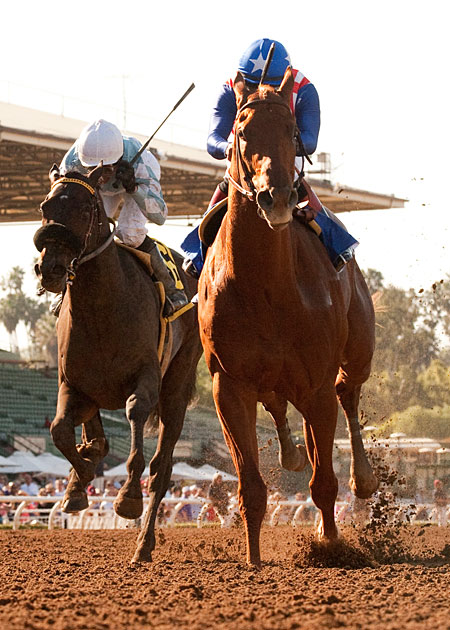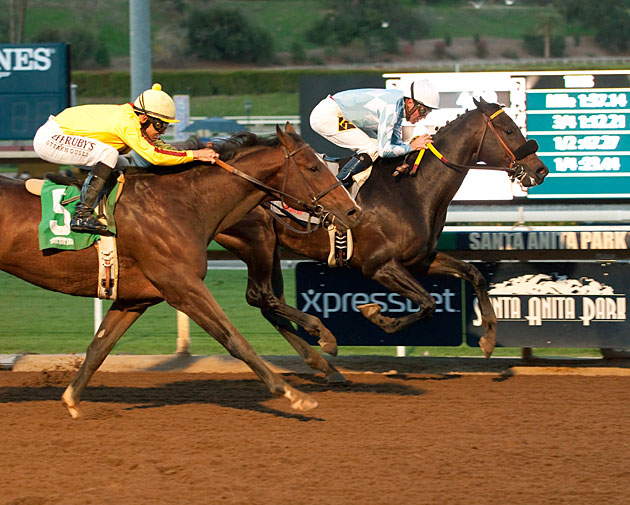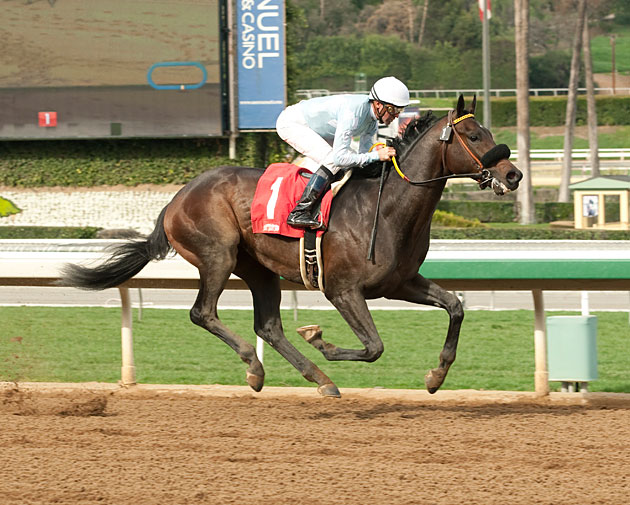Sise Has Prospect Park Gunning for Dortmund

If Cliff Sise had any choice in the matter, he'd still be at Rancho Paseana, breaking babies for Pam and Martin Wygod about five miles east of the seaside racetrack of Del Mar.
What was most important was that he was around horses constantly, a common thread that has weaved through his adult life.
"It was like being in paradise every day," the 63-year-old trainer said of Rancho Paseana, a ranch that was closed after owner Jenny Craig sold the facility to Bill Gates in 2013. "Down there, even in the summer, you'd get a breeze that kicks through. I like wherever I'm at, but it was just great for horses."
It was at Rancho Paseana where Sise broke multiple grade I winner Shared Belief for the Wygods, who bred the current superhorse in Kentucky. "Thank God I wasn't the one who (gelded) that horse," Sise says.
"He's a natural horseman, that's why we asked him to go there—he does everything right," Martin Wygod said in the company of the trainer, forcing Sise to turn away, blushing from the compliments. "He is so attentive to detail—conscientious. He lives at the barn.
"I don't pay him, so I might as well give him complements," Wygod added with a wry grin.
Now Sise resides mostly at San Luis Rey Training Center in Bonsall, Calif.—about 20 miles north of Rancho Paseana and Del Mar, and close to 75 miles south of Santa Anita Park.
The aura of San Luis Rey suits Sise and his long, thoughtful stares while training his crop. Surrounded by an overgrown former golf course, condos, and a gated community, it is infinitely more relaxed than the congested highway Santa Anita can be during morning workouts. Take away the palm trees and the rolling bright-green hills surrounding the training track would be more reminiscent of Kentucky than north San Diego County. It's not Paseana, but it's not far off.
After a detour through Saudi Arabia, where he spent two months training after Rancho Paseana closed but quickly returned home, the training track that is just far enough away to feel serene is where Sise has his first Triple Crown hopeful since 2004 runner Lucky Pulpit stabled most of the time.
His name is Prospect Park, a leggy Tapit homebred owned by the Wygods. At 17 hands, the colt out of Bertrando mare Quiet Romance is only a notch shorter than the imposing Dortmund, who defeated Prospect Park in his only Triple Crown prep to date—the March 7 San Felipe Stakes (gr. II) at Santa Anita.
BALAN: Rivals Back to Challenge Dortmund in SA Derby
Prospect Park was second to Dortmund by 1 1/4 lengths that afternoon, but it was how that result came about that has all his connections excited, including jockey Kent Desormeaux, who was audacious after their second-place finish to the undefeated Bob Baffert trainee.
"They got the battle," Desormeaux quipped. "We'll win the war."
Sise, Wygod, and Desormeaux all point to Prospect Park's last four jumps in the 1 1/16-mile San Felipe—where he began advancing quickly on Dortmund to the wire—as the main source of their optimism. Add another sixteenth in the 1 1/8-mile $1 million Santa Anita Derby (gr. I), and Prospect Park's connections feel they have a winning formula.
"When I lined him up, he just took off," Desormeaux said. "The facts are there, because the time is there. I went 24 seconds the last quarter and Dortmund went (slower). I ran faster than him. We just ran out of ground. Those are facts."
Prospect Park's connections factor in the relatively slow pace of the San Felipe as well, where Dortmund was allowed to lead with fractions of :23.12, :46.98, and 1:11.30 without much pressure.
"Both of (Baffert's) last races—American Pharoah (in the grade II Rebel Stakes) and Dortmund (in the San Felipe)—they handed him the lead," Sise said. "There were five speed horses—and that's why we didn't want to go with him—and nobody goes with him. He gets off in 1:11 1/5."
"Was it a great ride by the winner or was it seven bad rides by the guys behind him?" Desormeaux added. "The horse is 3-5 and he's going :47 on the lead? My goodness. That's not supposed to happen. I was out of position to be the one that keeps him honest."
There are other aspects as well—Prospect Park had to go four wide in the first turn and ran into some trouble between horses at the quarter pole—but conclusions drawn from all that information is still somewhat speculative. Executing the plan and avoiding trouble on the track is another story entirely.

Desormeaux compares it to being a horseplayer. Sure, the money you make is nice, but the feeling of being right might be better.
"You can draw it on paper all you want, but that's what is great about being a jockey," Desormeaux said. "It's one thing to win. It's another to achieve a plan. To have success with a plan that's predetermined is so hard to do on a racetrack. But there's nothing like outwitting your peers and manipulating a race to your benefit."
On top of the issues that arose in the San Felipe, the dark bay colt's maturation might be paramount regarding his Triple Crown hopes.
At San Luis Rey, Prospect Park looks almost black in the shade (Wygod says "he has the look of a seal"). He struts around calmly after morning gallops, and dozes off during baths. When he ships north to Santa Anita, he relishes his windowed stall—a benefit of being the "Big Horse" in Sise's barn—which gives him a stunning view... of a dumpster.
"It's a view of a garbage can, but it's really amazing how much he loves it," Sise said. "The highlight of a stall up there is the end stall with a window. He hangs out at the window and he'll even sleep at the window. He takes his naps there. He goes right to that window and goes to sleep."
Prospect Park's progress as a racehorse is easy to see on past performances. He was sixth, five lengths back, in his 2-year-old debut at Del Mar in a maiden special weight event, although Wygod said he hated the synthetic surface. It took three more tries at that level, at Santa Anita, for the colt to get to the winner's circle Dec. 27, when he won by a head just in front of Cyrus Alexander in his first start with Desormeaux.
"He was like a teenager who is 6-foot-2," Wygod said.
That may have been the turning point, because in his next start and 3-year-old debut, the colt romped to a 5 1/4-length victory, with Desormeaux aboard again, in a mile allowance/optional claiming test Jan. 30, his tuneup for the San Felipe.
"I thought he was a tremendous athlete the second time I rode him," Desormeaux recalled. "The first time, he just barely won and he was just racing as a young horse. He was still on a learning curve. For whatever reason, the light went on, because the next time I rode him was just inspiring, the way he had such an amazing turn of foot and precocious speed… The only question was how far can he carry his speed. Now there's no question at all."
The change was even evident in the mornings, during workouts and gallops at San Luis Rey.
"He's changed from a spunky kid that didn't know what was going on, to a maturing (colt)—he's just evolved," said exercise rider Joe Steiner, who has breezed his fair share of outstanding horses, most notably Silver Charm, Real Quiet, and Lookin At Lucky . "Once he broke his maiden, we breezed him and he just grew all around… I was sitting behind this other horse they had work in front of him and now he's learned to respond when you ask him. 'OK, let's go,' and he ate him up and ran by him. He's blooming as we go along. He's not peaking yet."
The next step is a tricky one, however, with no real margin for mistakes. With 20 points and in 20th place in the "Road to the Kentucky Derby" standings, a first- or second-place finish in the Santa Anita Derby would be necessary to secure a spot in the 20-horse lineup on the first Saturday in May at Churchill Downs.
What he is, by all accounts, is capable. What remains is putting the pieces together.
"He has that stride—that's what I call it," Desormeaux said. "His cruising speed is faster than most can run, but what it takes out of those kinds of horses, to become champions, is the ability to position themselves and idle again. Speed up and then idle again, and then speed up and idle again. He can do that and not all horses can. When you press the button on most horses, you're gonna drain the tank. That's his intrinsic value."
Sise does his best to shrug off thinking too far ahead, in the time-honored, superstitious horseman's tradition of trying not to jinx himself.
"It feels good at this point, but you've got to be cautious," Sise said. "You hope to God he makes it there and runs good, because they can fall like flies."
A Triple Crown run would undoubtedly be cherished by the trainer, who grew up in the shadow of Santa Anita in Arcadia, Calif. and still remembers the two-hour traffic jam after the packed grandstand used to empty out on race days. But the sense from him is that he'll be at ease if it doesn't happen, as long as the horse is healthy and happy.
As Sise travels from the barn to the training track at San Luis Rey on any given day, he gushes about every runner in his stable. Whether a Triple Crown contender, an unraced horse, or an $8,000 claimer, they're all full of potential in his eyes.
"I think the world of all of them. I don't care if it's a Kentucky Derby horse or a claimer. When they throw their heart at you," he said, tapping his chest, "that's what you appreciate. If you don't love that, you shouldn't be training."
He speaks most fondly of a horse named Idiot Proof, one of just two graded stakes winners he's trained (the other was Paying Dues) who won nearly $1.3 million for the Wygods.
"He's never had the kinda crop or talent to work with, so he used to have to make it out of obscurely-bred horses. He did it with one of mine, Idiot Proof, by Benchmark out of a dam that hadn't produced anything," Wygod said. "He deserves this. He's a natural horseman. People don't recognize it enough."
